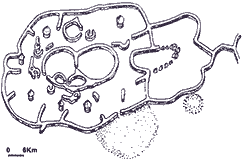There is no evidence of Stone Age settlements in the reserve, although a hand axe approximately 500 000 years old and a cleaver probably 100 000 years old that have been found, suggests stone age man hunted in the area. The Early Sotho-Tswana Settlers.
Sotho-Tswana people moved into the Garden of Eden which was the Highveld at that time in about 1300. Being pastoral people they settled in the area between Alberton, Soweto and Suikerbosrand. Archaeologists have been able to identify the people who lived in the area through the style of pottery known as “Moloko” which have been unearthed and also the layout of the villages is typically Sotho-Tswana. The warm wet climate of the highveld between 1300-1600 and 1750-1800 was ideal for growing sorghum and millet. Maize was introduced to the Tswana who lived near Maputo in about 1800. Subsequent settlers in this area also grew maize. The number of cattle which they owned measured their wealth, goats supplied milk and sheep were kept purely as a food source and for their pelts.
Kraal Layout
There were two distinct styles of kraal
layout. The earlier kraals were shaped
like a fried egg: The cattle were housed
in a stone walled central area (the yoke
and the outer wall marked the boundary
of the kraal. Later settlements adopted
the ‘sunflower’ shaped configuration: The
cattle in the centre and the petals being
the living areas. Each area would consist
of one of the headman’s wives and her
children or single men and women.
As a rule the Chief or headman had his living area at the back of the kraal facing
downward. His wives and other residents were then arranged in order of importance
down to the entrance.
The living area at the entrance was always occupied by young unmarried men, whose
job it was to guard the entrance from intruders. Entrance to the kraal was by invitation
only and visitors had to wait outside until they were invited into the kraal.
Ash Midden
An ash midden was always established at the entrance to the kraal and the cattle were driven over the ash thus minimizing the infection of ticks and other pests. There was
also an ash pit into which all garbage, broken pottery, bones, broken spears, axes and
obviously ash where thrown. Finding these ash pits is an archaeologist’s dream.
They also used to develop a grain store that consisted of a
hole in the ground lined with cow dung. Grain was stored in
the hole, which was sealed with cow dung, to be used in the
winter months. The exact position of the granary was a well-
kept secret. Later structures were above ground.
There are no iron ore deposits in the area, so the Tswana who lived in the Klipriviersberg had to trade agricultural products for iron implements and weapons with their counterparts who lived in the Melville Koppies and Lonehill area. Preserved forges can still be seen in these areas.
Social Upheaval
Severe drought was probably the reason why they lived in the area intermittently from
1300-1600 and then from 1650-1800. Although it is widely believed that some serious
social occurrence caused them to leave the area permanently. One theory relating to
the social upheaval was that the whole country suffered a severe drought towards the
beginning of the 1800’s. Because of the drought the strong and more militant tribes
swept through the country attacking the smaller settlements.
